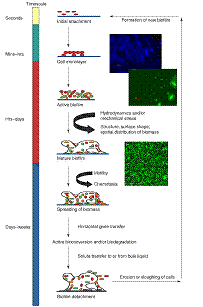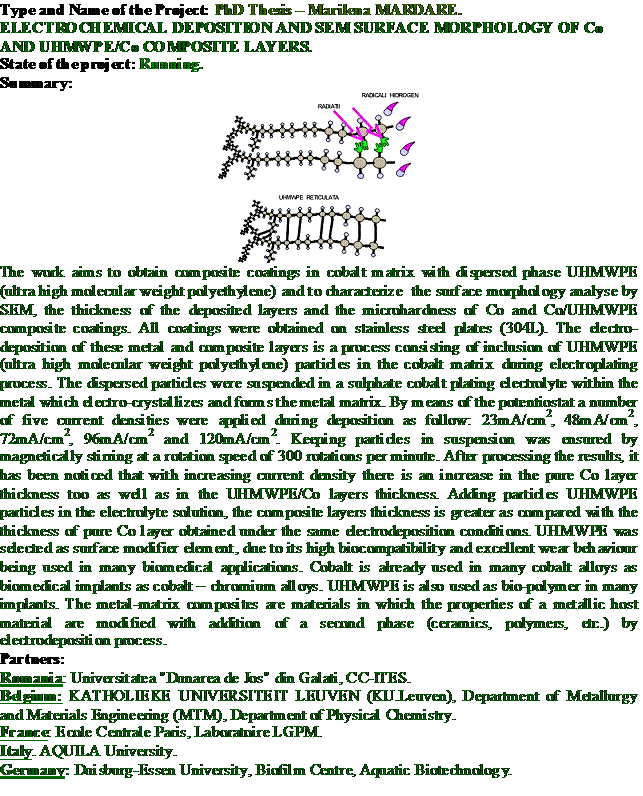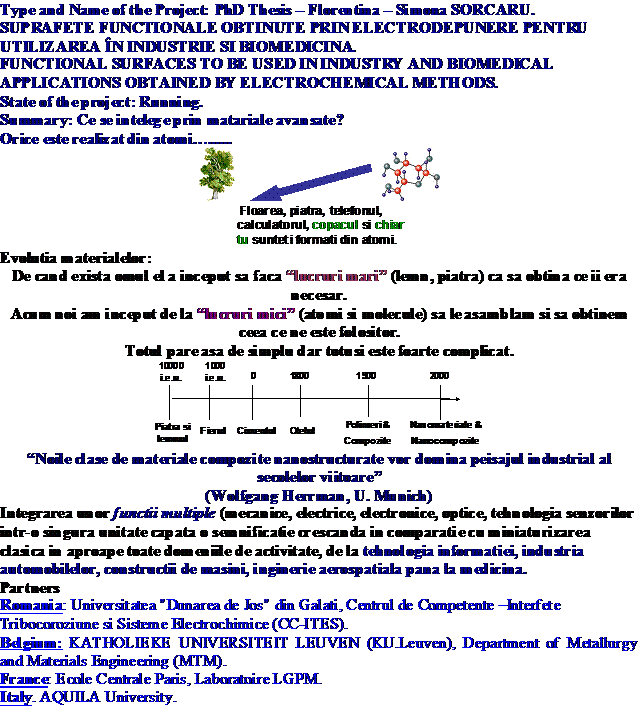PROIECTE CERCETARE
Projects Coordinator (Director)
Prof. Dr. Lidia BENEA
Passed
Projects
1.
Type and
Name of the Project
COST 521 CORROSION OF STEEL IN REINFORCED CONCRETE
STRUCTURES
RO1:
“Comparative corrosion studies of Zn-Fe alloy
coatings and Zn coatings on steel reinforcing structures”
Status of the project:
Finalised 2002
International cooperation with other countries:
Summary: 
Corrosion of steel in concrete is one of the major problems
with respect of the durability of reinforced concrete
structures. Reinforcing steel in concrete is thought to
develop a protective layer that shields the surface from
further corrosion. The protective layer develops from or is
enhanced by the high pH of the concrete. Corrosion rates
that result in serious damage may take more than a decade to
be detectable by rust and cracks at the concrete surface.
Therefore, there is a need for non-destructive methods that
can clarify the severity of corrosion earlier. More
knowledge and better methods are desirable. It is more
complicated to investigate the corrosion of steel in
concrete by electrochemical techniques than corrosion of
metals to different solutions. In solutions, a cell and
electrodes systems can be arranged on a good geometry for
electrochemical measurements. In concrete, interpretation of
the measurements is more dependent upon theoretical
considerations.
Partners
Romania:
"Dunarea de Jos" University of Galati, Faculty of
Metallurgy and Materials Science; INCERC Bucuresti.
France:
Ecole Centrale Paris, Laboratoire C.F.H.
2.
Type and Name
of the Project
COST 520 BIOFOULING AND MATERIALS
RO1:
"Marine bio - corrosion of SiC-Ni nano-structured composite
coatings".
International cooperation with other countries:
Status of the project:
Finalised 2002
Summary

Marine biofouling is one of the most important problems
currently facing marine technology. In the marine
environment any solid surface submerged in sea water will
become covered by a complex layer consisting of an organic
conditioning film, microfouling and macrofouling organisms
such as marine bacteria, algae, protozoa, barnacles, mussels
and tube worms. These fouling organisms cause serious
technical problems by settling on ships' hulls, power plant
cooling systems, aquaculture systems, fishing nets,
pipelines and other marine infrastructure. Ships suffer
increased drag and surface corrosion, leading to lower
speeds, thereby causing higher fuel consumption additional
CO2 emissions and maintenance costs.
Partners:
Romania:
"Dunarea de Jos" University of Galati, Faculty of
Metallurgy and Materials Science, faculty of Science,
University "Polytechnica" of Bucharest.
France:
Ecole Centrale Paris, Laboratoire C.F.H.
Italy:
Trento University, Faculty of Materials Engineering
3.
Type and Name
of the Project
COST 532:
Triboscience and Tribotechnology: Superior Friction and Wear
Control in Engines and Transmissions (2002-2007).
RO1:
"Nano-structured
composite coatings obtained by electrodeposition to be used
in tribocorrosion systems: processing and properties
investigation".
International cooperation with other countries:
Status of the project:
Passed
Summary

Tribocorrosion deals with the interaction of mechanical
(wear) and chemical (corrosion) degradation phenomena
leading to performance degradation and system failure. It
represents an important economic factor for industry,
including precision machines and devices, food processing,
transportation systems as well as coating and lubricant
fabrication. Tribocorrosion phenomena are still
insufficiently understood at present, and more reliable
methods for the prediction and optimisation of tribological
systems are needed. In this multidisciplinary international
project, mechanical, electrochemical, and surface science
methods will be used for the investigation of friction and
sliding wear of selected material systems immersed in a
corrosive or aqueous environment, namely tap water as a
possible replacement for environmentally hazardous organic
lubricants. That study will be done at a macroscopic, a
microscopic and a molecular level. The selected materials
can be described as ‘tribo-reactive’ ones since they can
react chemically with the environment especially in the wear
track where surface films can be mechanically destroyed.
Partners
Romania:
"Dunarea de Jos" University of Galati, Faculty of
Metallurgy and Materials Science. University "Polytechnica"
of Bucharest
Belge:
KATHOLIEKE UNIVERSITEIT LEUVEN
(KU.Leuven), Department of Metallurgy and Materials
Engineering (MTM)
France:
Ecole Centrale Paris, Laboratoire C.F.H.
Italy:
Trento University, Faculty of Materials Engineering
Hungary:
Eotvos Lorand University of Budapest.
4.
Type and Name
of the Project
COPBIL: Romania - Belgia (Flandre)
Tribocorrosion of engineering materials in view of their
industrial use as sliding parts in pumps, shafts, and motors
operated in water-lubricated conditions (2003-2005).
Status of the project:
Passed
Summary

The mutual
interactions between tribo-active materials and
biodegradable additives on each other are not yet fully
known. Such additives are required to get control on the
corrosiveness of tap water on many engineering materials and
to a improve the load bearing capacity of water as
lubricant. The testing of some promising material
combinations in expensive component testing can only be
performed after selection of the best combinations.
*
Inventory and effectiveness of biodegradable additives to
water for achieving low friction and high wear resistance,
*
Mechanism of degradation and restoration of triboreactive
surface layers on sliding engineering materials immersed in
water.
Two topics will be developed, namely:
-
characterisation by electrochemical transient measurements,
-
characterisation and modelling of tribochemical reactions in
nano- and micro-sliding contacts.
Partners
Romania:
"Dunarea de Jos" University of Galati, Faculty of
Metallurgy and Materials Science.
Belgium:
KATHOLIEKE UNIVERSITEIT LEUVEN
(KU.Leuven), Department of Metallurgy and Materials
Engineering (MTM)
5.
Type and Name
of the Project
COPBIL: Romania
–
Franta:
ETUDE DE DÉPOTS COMPOSITES NANOSTRUCTURÉS,
POUR LA PROTECTION DES SURFACES MÉTALLIQUES CONTRE LA
TRIBOCORROSION (STUDIUL STRATURILOR COMPOZITE
NANOSTRUCTURATE OBTINUTE ELECTROCHIMIC, DESTINATE PROTECŢIEI
SUPRAFEŢELOR METALICE IMPOTRIVA TRIBOCOROZIUNII (ACTIUNILOR
CUPLATE DE COROZIUNE SI UZURA MECANICA PRIN FRECARE)).
Status of the project:
Passed (2005-2006).
Summary 
Tribo-corrosion is a complex degradation (cracking,
corrosion, wear) process of metallic materials,
which results from the combined effects of mechanical
(including sliding and rolling friction, fretting, impacts,
erosion ...) and environmental (electrochemical or chemical)
solicitations occurring on their surfaces. Many aspects of
this tribocorrosion process are not elucidated yet, because
of the complexity of the individual mechanical and
environmental processes involved, and because a synergy
between these processes has to be considered. The research
works on tribo-corrosion processes should improve the
knowledge on viability and durability of a mechanical and/or
electrical contact. When a tribo-corrosion process occurs in
the presence of bio elements reacting with the materials
surface the process is then defined as a bio-tribologic
process. Tribo-corrosion as well as bio-tribologic processes
can modify the material degradation kinetics and even lead
to unknown surface properties. Tribo-corrosion is presently
a subject of interest in different countries of the European
Community and a need of joint research works and knowledge
exchanges seems to be necessary between the different
interested parties (industrials and scientific as well).
Partners
Romania:
"Dunarea de Jos" University of Galati, Faculty of
Metallurgy and Materials Science.
France:
ECOLE CENTRALE PARIS,
Laboratoire Corrosion - Fragilisation- Hydrogene.
6.
Type and Name
of the Project
COST 534:
New Materials and Systems for Prestressed Concrete
Structures.
State of the project:
Passed (2008).
International cooperation with other countries:
Summary 
Prestressing of concrete creates a compressive stress within
concrete that will partially or wholly balance the tensile
stresses that will occur in service. Concrete with a
reservation of strength in compression is an ideal material
for prestressing. Use of precast/prestressed concrete can
significantly improve the construction quality and achieve
substantial savings through reduction in onsite construction
time and costs. Unexpected construction downtime due to
weather condition is minimized. Furthermore, standardized
fabrication of precast concrete elements in an industrial
manufacture process can significantly improve quality of the
concrete structures. All these factors of marine
construction emphasize the value of prefabrication and
modular construction.
Partners
Romania:
"Dunarea de Jos" University of Galati, Faculty of
Metallurgy and Materials Science. University "Polytechnica"
of Bucharest, INCERC Bucharest.
France:
Ecole Centrale Paris, Laboratoire C.F.H.
Italy:
Trento University, Faculty of Materials Engineering.
7.
Type
and Name of the Project:
COST D19 -CHEMISTRY:
"Chemical functionality specific to the nanometer scale"
WG -Working
Group (reference D19/009/03) entitled “Development of new
nanostructured functional materials”
Title of the
Project:
"Nanostructured composite coatings obtained by
electrodeposition - processing and properties
characterisation".
State of the project:
Passed (2003-2007).
International cooperation with other countries:
Romania:
"Dunarea de Jos" University of Galati, Faculty of
Metallurgy and Materials Science. University "Polytechnica"
of Bucharest
Belgium:
KATHOLIEKE UNIVERSITEIT LEUVEN
(KU.Leuven), Department of Metallurgy and Materials
Engineering (MTM)
France:
Ecole Centrale Paris, Laboratoire C.F.H.
Italy:
Trento University, Faculty of Materials Engineering
Hungary:
Surface Chemistry and Corrosion Research, Chemical Research
Centerof Budapest.
Summary: 
The proposed project
contributes to our medium and long-term generic research,
enhances the competitiveness and encourages new research
objectives stimulated by the European Community. By this
way, the Romanian Research Centre, CC-ITES (Interfaces-Tribocorrosion
and Electrochemical Systems) can strengthen its leading
role in its traditional research objectives, can develop new
research fields at international level, therefore, the
CC-ITES can be a basic institute in building the
knowledge-based society in this field for Romania, helping
the enterprises and universities in education and research.
The present work has
the purpose of realisation and investigation of the
nanostructured composite layers by using (for the first
time) nanodispersed particles (for example SiC mean diameter
20nm).
8.
Titlul si tipul
proiectului
Proiect tip A: CNCSIS – Grant 1347:
STRATURI COMPOZITE NANOSTRUCTURATE OBTINUTE ELECTROCHIMIC,
DESTINATE PROTECTIEI SUPRAFETELOR FUNCTIONALE IN SISTEME
TRIBOCOROZIVE.
(NANOSTRUCTURED COMPOSITE COATINGS OBTAINED BY
ELECTRODEPOSITION FOR FUNCTIONALLY SURFACES PROTECTION IN
TRIBOCORROSION SYSTEM).
(2005-2006).
Situatia
proiectului:
Passed
(2005-2006).
Summary:

Following the
EU Commision concept on promoting nano-technologies and
nano-sciences, knowledge based multifunctional materials and
new production process our project aims to multidisciplinary
studies of functionally surfaces obtained by
electrodeposited nanostructured composite coatings. New
nanostructured materials by codeposition of nanometric sized
dispersed ceramic particles as SiC 20 nm nm with metallic
matrices will be obtained. The mechanism and kinetik of
codeposition will be studied by electrochemical techniques
(EIS, PD cathhodic diagrams and I-E transients). The
properties characterisation will be correlated with the
performances requested in the field of uses as functional
surfaces to improve the corrosion and wear resistance. By
high level techniques as scanning and transmission
electronic microsopy as well as atomic force microscopy and
ultramicrotopography the correlation between nanostructures
obtained and modification induced by dispersed particles
will be done.
Partners:
Romania:
Universitatea
"Dunarea de Jos" din Galati, Facultatea de Metalurgie
si Stiinta Materialelor.
Belgia:
KATHOLIEKE UNIVERSITEIT LEUVEN
(KU.Leuven), Department of Metallurgy and Materials
Engineering (MTM)
Franta:
Ecole Centrale Paris, Laboratoire C.F.H.
Italia:
Trento University, Faculty of Materials Engineering.
9.
Type and Name
of the Project:
COST 533
Action on Materials for Improved Wear Resistance of Total
Artificial Joints.
Title of the
Project:WG3 – Tribochemistry:
Alternative materials: Cobalt - matrix composite
coatings.
International cooperation with other countries:
State of the project:
Passed (2006-2009).
Summary:

Obtaining new super-performant materials led to the
development of a class of products known as composite
materials.
A
new method proposed for improving the properties of
materials intended for biomedical applications is to use
composite layers in the Co metal matrix with dispersed
phases.
Fundamental requirements for biomaterials used in the
construction of medical devices and artificial organs are
biocompatible surfaces and favourable mechanical properties.
Advances in medical treatment also demand substantial
improvements in biomaterial properties. Conventional
single-component polymer materials cannot satisfy these
requirements. Therefore, multi-component polymer systems
have been designed and prepared for developing new
multifunctional biomaterials. Many biomaterials have been
prepared by the immobilization methods such as the coating,
grafting, or reacting of biocompatible polymers with the
surface of substrates such as segmented polyurethane, nylon,
polystyrene, and poly(ethylene terephthalate). Other methods
include blending of the biocompatibility polymer with the
substrate. In the above-mentioned methods, the surface
properties can be controlled although the mechanical
properties are hardly changed since they retain the
properties of industrial substrate that does not adapt to
tissues and organs. For instance, the difference in
mechanical properties between a native artery and an
artificial blood vessel induces hemodynamical flow
disturbance and stress concentration near the anastomoses,
causing further thrombus formation and neointimal
hyperplasia. Therefore, biomaterials require mechanical
properties that are matched with various regions such as
soft tissue, hard tissue, and organs as well as corrosion
and tribocorrosion resistance. To create the polymer
biomaterials corresponding to the purpose and use
conditions, methods that can control both the bulk
properties and the surface properties are necessary.
Partners:
Belgium:
KATHOLIEKE UNIVERSITEIT LEUVEN
(KU.Leuven), Department of Metallurgy and Materials
Engineering (MTM).
France:
Ecole Centrale Paris, Laboratoire LGPM.
10.
Type and Name
of the Project:
COST D33 ACTION:
Nanoscale Electrochemical and Bioprocesses (Corrosion) at Solid-aqueous
Interfaces of Industrial Materials.
State of the project:
Passed (2006-2009).
International cooperation with other countries:
Summary:
Bacteria adhesion is a very complicated process affected by
many factors: bacterial/material properties and environment.
Surface modification enables the evaluation of the effect of
these parameters on bacterial adhesion. A rigorous study of
the effects of surface chemistry / topography on bacterial
adhesion and protein adsorption requires a model system that
allows precise control of the type and the configuration of
functional groups at the substrate surface under dynamic
conditions. Regarding the environment it was observed that
bacterial concentration versus time of exposure increases
with increasing bacterial concentration and time up to a
saturation level, specific for each type of
surface-bacterial strain. Concentration of electrolytes, CO2,
pH and ionic strength depending on bacteria and material
surface characteristics presence of Antibiotics decreases,
depending on bacterial susceptibility and antibiotics
concentrations.
All these factors may influence bacterial adhesion by either
changing physical interactions in phase one of adhesion or
by changing surface characteristics of bacteria or
materials.
Bacterial
characteristics influence also biofilm formation and growth.
hydrophobic
bacteria prefer hydrophobic material surfaces. Materials
Characteristics and Chemistry of surfaces are the most
important factors in bacterial adhesion and biofilm growth.
Representation of cyclic steps involved in the
formation of an active biofilm are presented in Fig.

The processes
of formation and detachment of cells are repeated in a
cycle, thereby enabling further development of similar
biofilms, which can subsequently attain new dimensions as a
result of environmental influences.
Partners:
Belgium:
KATHOLIEKE UNIVERSITEIT LEUVEN
(KU.Leuven), Department of Metallurgy and Materials
Engineering (MTM).
France:
Ecole Centrale Paris, Laboratoire LGPM.
Germany:
Duissburg-Essen University,
Biofilm Centre,
Aquatic Biotechnology.
11.
COST 636
Type and Name
of the Project: COST 636 Action:
XENOBIOTICS IN THE
URBAN WATER CYCLE.
Project:
The Influence of Urban and Suburban
Water Characteristics on Green Vegetables Quality.
Project Coordinator:
Lecturer Dr. Paula POPA.
State of the project:
Passed
Summary: 
Cost Action 636
covers a large range of issues regarding xenobiotics in the
urban water cycle, from analytical questions and treatment
methods to impact assessment and fluxes
Control of Water quality - nitrate and nitrite.
Method of investigation - Romanian law, European law.
Investigation nitrate and nitrite in green vegetables.
What are the influences of nitrate and nitrite over human health?
13)

14)

15)

16)

17)

18)
|
|
|
PhD Expert:
QUALITY DEVELOPMENT OF THE RESEARCHERS FORMATION
BASED ON IMPROVED DOCTORAL PROGRAMS DEVELOPED
THROUGH PARTNERSHIP.
SOPHRD/21/1.5/G/ID 19524
Director Proiect:
Prof. Dr. Maria VLAD.
Responsabil Relatii Internationale(External
relations
officer):Prof.
Dr. Lidia BENEA.
Partners:
UNIVERSITATEA DUNAREA DE JOS DIN GALATI address
Str. Domneasca nr. 47, Romania, cod postal 800
008, tel +40 236 413602, fax +40 236 461353,
www.ugal.ro,
fiscal cod 3127522, reprezented by prof.dr.
Viorel MINZU, Rector - main partner
n
2.
ECOLE CENTRALE PARIS, address Grande Voie des
Vignes, F-92 295 Châtenay-Malabry Cedex, France
, Phone +33 1 41 13 12 44, Fax: +33 1 41 13 12
62, site:
www.ecp.fr,
fiscal cod 999445224, represented by prof. dr.
Hervé Biausser, Director -partner1
n
3.
ECOLE NATIONALE SUPERIEURE DE CHIMIE DE
PARIS, address Chimie Paris ParisTech 11,
rue Pierre et Marie Curie ,75231 Paris Cedex 05,
France, Phone 0143295474 , Fax: 143292059, site:
www.enscp.fr
, fiscal cod
1975337550017,
represented by prof. dr.
Alain Fuchs, Director - partner2
n
4.
KATHOLIEKE UNIVERSITEIT LEUVEN, BE LEUVEN 01,
address Oude Markt 13 B-3000 Leuven Belgium,
Phone: +3216324010 Fax :+3216322991,
www.kuleuven.be, fiscal cod
BE
419.052.173
,
represented by prof. dr. Marc Vervenne,
Rector-partner 3.
 |
|